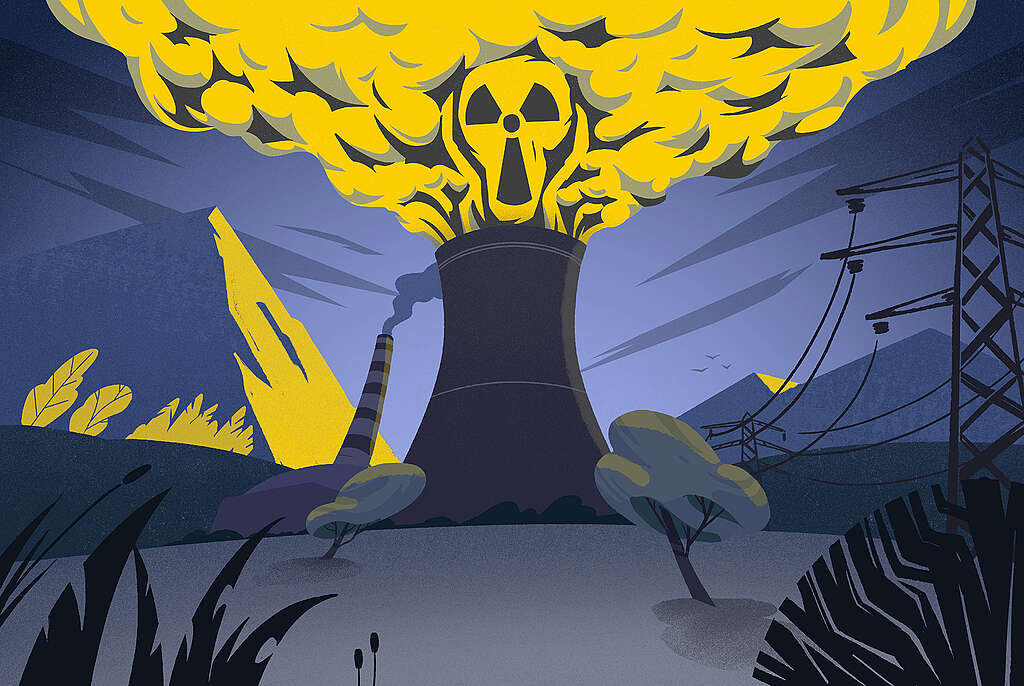China and the U.S. Are Numb to the Real Risk of War.

Like China, the United States is mired in jingoism and confusion. Like China, it has no idea what it would do if things go wrong.
With the 2024 U.S. presidential election heating up, the one thing every candidate, Democrat or Republican, has done is to show how tough they could get on China.
Like China, the United States is mired in jingoism and confusion. Like China, it has no idea what it would do if things go wrong. With the 2024 U.S. presidential election heating up, the one thing every candidate, Democrat or Republican, has done is to show how tough they could get on China.
The pair are dangerously close to the edge of nuclear war over Taiwan—again.
May 12, 2024, By Sulmaan Wasif Khan, the Denison chair of international history and diplomacy at Tufts University’s Fletcher School. https://foreignpolicy.com/2024/05/12/china-us-taiwan-strait-war-nuclear-weapons-military-biden-xi-history/
On the morning of April 5, 2023, Taiwan’s president, Tsai Ing-wen, met with then-U.S. House Speaker Kevin McCarthy in Simi Valley, California. This was a meeting Beijing had warned against in the strictest of terms. It was therefore a meeting that both sides found necessary to have. China had to be shown that it could not dictate whom either Taiwan or the United States met with. On this, both Taipei and Washington were agreed.
China delivered on its promised forceful response by engaging in military drills and sending warships and planes scudding around Taiwan. The median line and Taiwan’s air defense identification zone were breached. One aircraft carrier, the Shandong, entered the waters just south of Japan. Violations of the “One China” principle, Beijing had to make clear, were not going to be taken quietly. And in seeking to make that clear, it deepened the risk of war.
This article is adapted from The Struggle for Taiwan: A History of America, China, and the Island Caught Between by Sulmaan Wasif Khan,
Commentators dismissed Beijing’s response to the Tsai-McCarthy meeting as less intense than the one that had attended then-U.S. House Speaker Nancy Pelosi’s visit to Taiwan in 2022. But the dismissal itself highlighted the gravity of the problem. A certain level of military activity had become normalized. It was as though the world now took for granted the presence of missiles and aircraft carriers, the shows of force that demanded a response in kind. The week after the meeting in California, the United States and the Philippines launched their largest joint military exercise to date. It was a way of showing China that there were other militaries that could operate in the region. The new normal meant more ships and planes operating in close proximity to one another, mutual recrimination, and mutual suspicion.
Beijing and Washington have become desensitized to the risk these circumstances pose. But in the militarization of foreign policy and the failure to grasp the full significance of that militarization, the pair are one accident and a bad decision removed from a catastrophic war. Mathematicians speak of the “edge of chaos”: the final point separating order from doom. A system operating at this edge has no room for error. This is where the accumulated weight of the past has brought the United States, China, and Taiwan. They walked right up to the edge of a war that could go nuclear several times in the past: in 1954-55, 1958, and 1996. Now, they seem to be living on that edge permanently.
In recent years, China’s policy has alienated Taiwan completely. As China has bullied, threatened, and displayed force at home and abroad, it has made unification unacceptable to much of the Taiwanese electorate. And it has enjoyed only mixed success in trying to isolate Taiwan diplomatically. It has managed to buy off many of Taiwan’s erstwhile allies, but its conduct over COVID-19 and support for Russia despite the invasion of Ukraine have cost it friends, too—and those former friends have turned to the island across the strait.
Since at least 2021, Taiwan has had a seemingly endless parade of visitors, from Germany’s education minister to Liz Truss, the former U.K. prime minister. In November 2021, the European Parliament sent its first official delegation to the island; the head of the delegation, Raphaël Glucksmann, told Tsai, “We in Europe are also confronted with interference from authoritarian regimes and we came here to learn from you.” In October 2022, Tsai received lawmakers from Lithuania and Ukraine; the former had recently established a representative office in Taiwan despite Beijing’s anger, while the latter was making a gesture of solidarity with a country that, unlike China, had been sharp in its criticism of Moscow. A Japanese parliamentary delegation that arrived in December 2022spoke glowingly of Tsai’s defense plans and emphasized Japan’s own determination to keep the status quo in the region from being “changed by force or unilaterally.” China has warned against or condemned many of these visits.
Beijing has only itself to blame for Taiwan’s strengthened diplomatic position. Its wolf warrior nationalism and reluctance to break with Moscow have cost it European support. If visits from foreign politicians were to translate into condemnation of China at the United Nations, Beijing could veto a Security Council resolution. In this case, like Russia, China would find itself a pariah state—and unlike Russia, China cares about how it is seen by the world. China’s own corrosive nationalism has eaten into its body politic, too It has not torn itself apart in a bout of political bloodletting, but it has certainly let loose the kind of jingoism that would allow that to happen. What it will decide to do in a crisis is uncertain. Beijing itself does not know.
The United States, meanwhile, seems intent on reviving a defense treaty with Taipei that it once spent more than a decade trying to break. Taiwan has become a means of showing China just how tough the United States can get. Washington is not clear on how getting tough will alter Beijing’s conduct, but “deterrence” is the concept invoked most often. A show of force, the thinking goes, will deter China from aggression. But what if deterrence fails? What if the show of force backs China into a corner from which it feels it has no option but to lash out? To this, Washington has few answers beyond preparing for war.
Some U.S. pundits have waxed lyrical about how they would fight a war with China. Taiwan, they opined, will be turned into a “porcupine” with hardened defenses. One former defense official suggested the use of “low-yield tactical nuclear weapons” in the event of a conflict with China. (The bombs dropped on Hiroshima and Nagasaki qualify as low yield.) The possibility of Russian President Vladimir Putin using such weapons sent shock waves of horror through the world, but the idea of employing them in a war with China became normal in some circles. There was no guarantee that, once the nuclear taboo was breached, the weapons would stay “low yield.” But the question of what would happen if the two powers escalated to higher-yield arms and plunged the world into nuclear holocaust has been left unresolved.
It is as though the United States is being haunted by all the ghosts of its long past with China and Taiwan, forcing it to relive questions it had once thought resolved. U.S. military leader Douglas MacArthur wanted to wage war against China in 1950. President Dwight D. Eisenhower considered using nuclear weapons against China in 1955 and 1958. Today, Washington abides by the “One China” principle, but it wants Taiwan to enjoy “self-determination.” It vows that it does not dispute the formulation that Taiwan is a part of China, but it will help Taiwan resist Chinese coercion. It wishes to promote Taiwan’s presence in international organizations, but it remains unwilling to recognize Taiwan itself. The United States has shifted from pure ambiguity to ambiguity with a tilt in favor of Taiwan—and it has done so because it decided China is an enemy.
Like China, the United States is mired in jingoism and confusion. Like China, it has no idea what it would do if things go wrong. With the 2024 U.S. presidential election heating up, the one thing every candidate, Democrat or Republican, has done is to show how tough they could get on China. Republicans vying for the nomination got in on the act early; former President Donald Trump has denounced French President Emmanuel Macron for “kissing Xi’s ass,” referring to Chinese leader Xi Jinping. Joe Biden, with the power of the incumbent, has not stopped at rhetoric. Whether supporting a TikTok ban unless the app is sold or calling for increased tariffs on Chinese goods, his policies are calibrated to demonstrate toughness on China.
Taiwan’s own presidential elections, held on Jan. 13, showed just how deeply the island’s electorate had turned against unification. At first, William Lai, the candidate from Tsai’s Democratic Progressive Party (DPP), vowed not to alter the status quo, though he accused Beijing of doing so. Taiwan, he argued, was already sovereign. There was no need to change what worked. But his caution soon vanished. While campaigning, Lai defined success for Taiwan as its leaders being able to visit the White House. This was a gauntlet thrown down—Taiwanese officials are blocked from visiting Washington. The Biden administration immediately demanded an explanation. This was not, U.S. officials made clear, how the relationship worked. Where Tsai had been prudent, Lai was willing to push his luck.
The Kuomintang (KMT), the main opposition party, was not leaning toward Beijing, either. Its nominee, Hou You-yi, the mayor of New Taipei City, said that he would reject both “one country, two systems” and a formal move for independence, but that if Taiwan were attacked, he would face the challenge. Taiwan, according to Hou, needed to be ready to defend itself. On the crucial question of how to deal with China, there was little difference between the policies Lai and Hou espoused.
A third candidate, Ko Wen-je of the Taiwan People’s Party, was calculatedly vague on China policy. His campaign made clear that he was depending on votes from traditional KMT supporters: those who would have favored a closer relationship with China. He claimed that he would find the middle ground between the KMT’s appeasement of China and the DPP’s provocation of it; he would make Taiwan a bridge for Sino-American communication rather than a front in a Sino-American war. How he proposed to do all this was left undefined.
Lai eventually won the presidency, but it was not the ringing triumph Tsai had won four years earlier. Lai scraped through with a mere 40 percent of the vote, his victory made easier by the fact that Hou and Ko had failed to join forces. As he prepares to take office on May 20, Lai faces a deeply divided, volatile populace and a legislature in which the DPP is bereft of a majority.
This is a point China has been quick to underline. The DPP, it huffed after the election, is not representative of “majority public opinion.” What is lost on Beijing is that the other candidates made clear that unification was not something they were willing to countenance either. Hou had made a point of not inviting Ma Ying-jeou, the last KMT member to serve as Taiwan’s president, to his rallies; he knew that to associate himself with Ma’s embrace of China would have doomed his candidacy. Beijing still does not understand Taiwan. Meanwhile, the United States continues to disavow support for Taiwanese independence while making plans for further delegations to the island. With the U.S. presidential election going into fifth gear, the risk of miscalculation will only rise.
At the edge of chaos, a single choice can make the difference between order and catastrophe. More than 80 years on from the Cairo Declaration, which held that Taiwan would be “restored to the Republic of China” at the end of World War II, we can see that there were myriad moments that could have yielded different outcomes, for better or for worse. If President Franklin D. Roosevelt had insisted on self-determination for Taiwan after World War II, if the Korean War had not happened, if Beijing had made “one country, two systems” work, if Taiwan had developed a nuclear weapon, if Pelosi’s plane had indeed been shot at—if someone had made a different decision at any of those moments, the world would be a radically different place.
When deterrence, toughness, and pride drive policy, the room for error diminishes to virtually nil. China, Taiwan, and the United States are at a point where the choices they make could spell the difference between peace and nuclear holocaust. Those choices are best made with the historical record—and all its unrealized possibilities—firmly in mind.
United States nuclear weapons, 2024
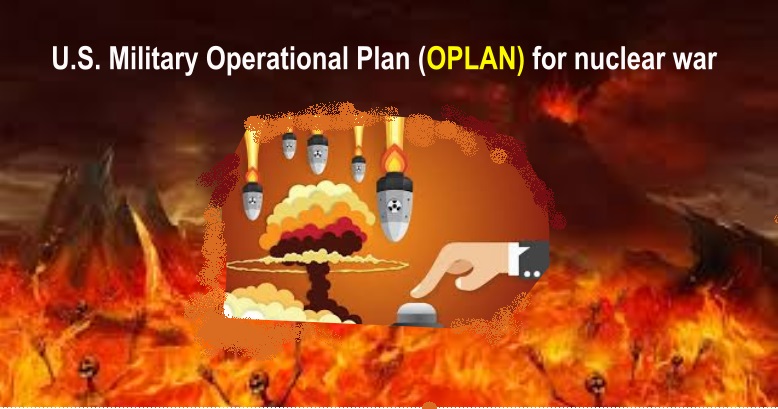
The current strategic nuclear war plan—OPLAN 8010–12—consists of “a family of plans” directed against four identified adversaries: Russia, China, North Korea, and Iran.
Just like previous NPRs, the Biden administration’s NPR said the United States reserved the right to use nuclear weapons under “extreme circumstances to defend the vital interests of the United States or its allies and partners” and rejected policies of nuclear “no-first-use” or “sole purpose” (US Department of Defense 2022a, 9)
Bulletin, By Hans M. Kristensen, Matt Korda, Eliana Johns, Mackenzie Knight | May 7, 2024
The United States has embarked on a wide-ranging nuclear modernization program that will ultimately see every nuclear delivery system replaced with newer versions over the coming decades. In this issue of the Nuclear Notebook, we estimate that the United States maintains a stockpile of approximately 3,708 warheads—an unchanged estimate from the previous year. Of these, only about 1,770 warheads are deployed, while approximately 1,938 are held in reserve. Additionally, approximately 1,336 retired warheads are awaiting dismantlement, giving a total inventory of approximately 5,044 nuclear warheads. Of the approximately 1,770 warheads that are deployed, 400 are on land-based intercontinental ballistic missiles, roughly 970 are on submarine-launched ballistic missiles, 300 are at bomber bases in the United States, and approximately 100 tactical bombs are at European bases. The Nuclear Notebook is researched and written by the staff of the Federation of American Scientists’ Nuclear Information Project: director Hans M. Kristensen, senior research fellow Matt Korda, research associate Eliana Johns, and program associate Mackenzie Knight.
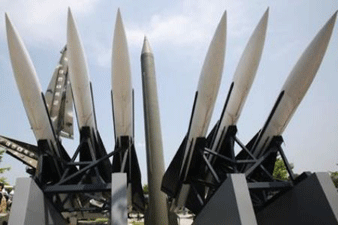
In May 2024, the US Department of Defense maintained an estimated stockpile of approximately 3,708 nuclear warheads for delivery by ballistic missiles and aircraft. Most of the warheads in the stockpile are not deployed but rather stored for potential upload onto missiles and aircraft as necessary. We estimate that approximately 1,770 warheads are currently deployed, of which roughly 1,370 strategic warheads are deployed on ballistic missiles and another 300 at strategic bomber bases in the United States. An additional 100 tactical bombs are deployed at air bases in Europe. The remaining warheads—approximately 1,938—are in storage as a so-called “hedge” against technical or geopolitical surprises. Several hundred of those warheads are scheduled to be retired before 2030 (see Table 1 on original).
While the majority of the United States’ warheads comprises the Department of Defense’s military stockpile, retired warheads under the custody of the Department of Energy awaiting dismantlement constitute a “significant fraction” of the United States’ total warhead inventory (US Department of Energy 2023b). Dismantlement operations include the disassembly of retired weapons into component parts that are then assigned for reuse, storage, surveillance, or for additional disassembly and subsequent disposition (US Department of Energy 2023b, 2–11). The pace of warhead dismantlement has slowed significantly in recent years: While the United States dismantled on average more than 1,000 warheads per year during the 1990s, in 2020 it dismantled only 184 warheads (US State Department 2021). According to the Department of Energy, “[d]ismantlement rates are affected by many factors, including appropriated program funding, logistics, legislation, policy, directives, weapon system complexity, and the availability of qualified personnel, equipment, and facilities” ……………………………………..
…………….. we estimate that the United States possesses approximately 1,336 retired—but still intact—warheads awaiting dismantlement, giving a total estimated US inventory of approximately 5,044 warheads.
Between 2010 and 2018, the US government publicly disclosed the size of the nuclear weapons stockpile; however, in 2019 and 2020, the Trump administration rejected requests from the Federation of American Scientists to declassify the latest stockpile numbers (Aftergood 2019; Kristensen 2019a, 2020b). In 2021, the Biden administration restored the United States’ previous transparency levels by declassifying both numbers for the entire history of the US nuclear arsenal until September 2020—including the missing years of the Trump administration. . This effort revealed that the United States’ nuclear stockpile consisted of 3,750 warheads in September 2020—only 72 warheads fewer than the last number made available in September 2017 before the Trump administration reduced the US government’s transparency efforts (US State Department 2021). We estimate that the stockpile will continue to decline over the next decade as modernization programs consolidate the remaining warheads.
Following the Biden administration’s initial declassification in 2021, it has since denied successive annual requests from the Federation of American Scientists to disclose the stockpile numbers for 2021, 2022, or 2023 (Kristensen 2023d). A decision to no longer declassify these numbers not only contradicts the Biden administration’s own recent practices, but also represents a return to Trump-era levels of nuclear opacity. Such increased nuclear secrecy undermines US calls for Russia and China to increase transparency of their nuclear forces.
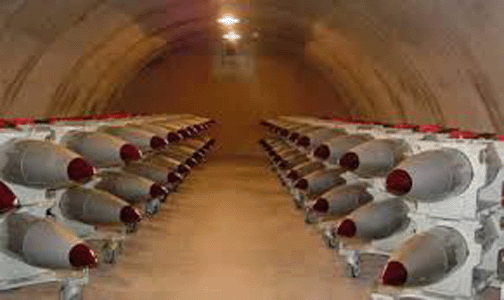
The US nuclear weapons are thought to be stored at an estimated 24 geographical locations in 11 US states and five European countries (Kristensen and Korda 2019, 124). The number of locations will increase over the next decade as nuclear storage capacity is added to three bomber bases. The location with the most nuclear weapons by far is the large Kirtland Underground Munitions and Maintenance Storage Complex south of Albuquerque, New Mexico. Most of the weapons in this location are retired weapons awaiting dismantlement at the Pantex Plant in Texas. The state with the second-largest inventory is Washington, which is home to the Strategic Weapons Facility Pacific and the ballistic missile submarines at Naval Submarine Base Kitsap. The submarines operating from this base carry more deployed nuclear weapons than any other base in the United States.
Implementing the New START treaty
The United States appears to be in compliance with the New Strategic Arms Reduction Treaty (New START) limits. Although Russia “suspended” its participation in New START in February 2023, the United States publicly declared in May 2023 that it had 1,419 warheads attributed to 662 deployed ballistic missiles and heavy bombers as of March 1st, 2023 (US State Department 2023a). The United States initially said that it voluntarily released the numbers “[i]n the interest of transparency and the US commitment to responsible nuclear conduct.” However, the United States did not continue this practice beyond that initial exchange and has not published any aggregate numbers since May 2023 (US State Department 2023a)
The United States contends that Russia’s “suspension” of New START implementation is “legally invalid” (US State Department 2023c). In response, the United States adopted four countermeasures in 2023 that it claimed were fully consistent with international law 1) no longer providing biannual data updates to Russia; 2) withholding from Russia notifications regarding treaty-accountable items (i.e. missiles and launchers) required under the treaty; 3) refraining from facilitating inspection activities on US territory; and 4) not providing Russia with telemetric information on US ICBM and SLBM launches (US State Department 2023c).
The New START warhead numbers reported by the US State Department differ from the estimates presented in this Nuclear Notebook, though there are reasons for this. …………………..
Since the treaty entered into force in February 2011, the biannual aggregate data show the United States has cut its arsenal by a total of 324 strategic launchers, reduced deployed launchers by 220 and the warheads attributed to them by 381 (US State Department 2011). The warhead reduction is modest, only equivalent to about 10 percent of the 3,708 warheads remaining in the US stockpile. ………….
As of March 2023, the United States had 38 launchers and 131 warheads less than the treaty limit for deployed strategic weapons but had 119 deployed launchers more than Russia—a significant gap that is just under the size of an entire US Air Force intercontinental ballistic missile (ICBM) wing. So far Russia has not sought to reduce this gap by deploying more strategic launchers but instead has increased the portion of its missiles that can carry multiple warheads.
The New START treaty has proven useful so far in keeping a lid on both countries’ deployed strategic forces. But it expires in February 2026 and if it is not followed by a new agreement, both the United States and Russia could potentially increase their deployed nuclear arsenals by uploading several hundred of stored reserve warheads onto their launchers.
Nuclear Posture Reviews and nuclear modernization programs
The Biden administration’s 2022 Nuclear Posture Review (NPR) was broadly consistent with the Trump administration’s 2018 NPR…………………………………
Just like previous NPRs, the Biden administration’s NPR said the United States reserved the right to use nuclear weapons under “extreme circumstances to defend the vital interests of the United States or its allies and partners” and rejected policies of nuclear “no-first-use” or “sole purpose” (US Department of Defense 2022a, 9)…………………………………………………………………………………………………………………………………………………
In 2023, multiple governmental advisory commissions published reports intended to influence US nuclear posture. The Congressionally-mandated report on “America’s Strategic Posture,” published in October 2023, included a broad range of recommendations for the United States to prepare to increase the number of deployed warheads, as well as to scale up its production capacity of bombers, air-launched cruise missiles, ballistic missile submarines, non-strategic nuclear forces, and warheads (US Strategic Posture Commission 2023). It also called for the United States to deploy multiple warheads on land-based intercontinental ballistic missiles (ICBMs) and consider adding road-mobile ICBMs to its arsenal…………………………………. the Strategic Posture Commission report’s status as a bipartisan document has been particularly useful for nuclear advocates to push for additional nuclear weapons (Heritage 2023; Hudson Institute 2023; Thropp 2023).
While additional modernization programs are being discussed, the National Nuclear Security Administration, or NNSA, delivered in 2023 more than 200 modernized nuclear weapons (B61–12 bombs and W88 Alt 370 warheads) to the Department of Defense (US Department of Energy 2024).
Nuclear planning and nuclear exercises
In addition to the Nuclear Posture Review, the nuclear arsenal and the role it plays is shaped by plans and exercises that create the strike plans and practice how to carry them out.
The current strategic nuclear war plan—OPLAN 8010–12—consists of “a family of plans” directed against four identified adversaries: Russia, China, North Korea, and Iran. Known as “Strategic Deterrence and Force Employment,” OPLAN 8010–12 first entered into effect in July 2012 in response to operational order Global Citadel. ………………………………………………………………….
…………………………………. changes are evident in the types of increasingly provocative bomber operations over Europe, in some cases very close to the Russian border (Kristensen 2022a). In October 2023, for example, a B-52 bomber from Barksdale AFB in Louisiana participated in NATO’s annual nuclear exercise Steadfast Noon, and in March 2023 a nuclear-capable B-52 cut south only a few kilometers from the Russian sea border and then flew south near Kaliningrad (Kristensen 2023a; NATO 2023).
…………………US strategy has changed in response to deteriorating East-West relations and the new “great power competition” and “strategic competition” strategy promoted by the Trump and Biden administrations, respectively. They also illustrate a growing integration of nuclear and conventional capabilities, as reflected in the new strategic war plan. B-52 Bomber Task Force deployments typically include a mix of nuclear-capable aircraft and aircraft that have been converted to conventional-only missions. With Sweden joining NATO, US strategic bombers now routinely operate over Swedish territory: In August 2022, for example, two B-52s—one version that is nuclear-capable and one that is de-nuclearized—overflew Sweden, the first overflight since it applied for NATO membership in May 2022 (Kristensen 2022c)…………………………………………………………………………………………….
Land-based ballistic missiles
The US Air Force (USAF) operates 400 silo-based Minuteman III ICBMs and keeps “warm” another 50 silos to load stored missiles if necessary, for a total of 450 silos. Land-based missile silos are divided into three wings: the 90th Missile Wing at F. E. Warren Air Force Base in Colorado, Nebraska, and Wyoming; the 91st Missile Wing at Minot Air Force Base in North Dakota; and the 341st Missile Wing at Malmstrom Air Force Base in Montana. Each wing has three squadrons, each with 50 Minuteman III silos collectively controlled by five launch control centers. We estimate there are up to 800 warheads assigned to the ICBM force, of which about half are deployed (see Table 1, on original).
The 400 deployed Minuteman IIIs carry one warhead each, either a 300-kiloton W87/Mk21 or a 335-kiloton W78/Mk12A. ICBMs equipped with the W78/Mk12A, however, could technically be uploaded to carry two or three independently targetable warheads each, for a total of 800 warheads available for the ICBM force……………………………………………………………………………………….
Part of the ongoing ICBM modernization program involves upgrades to the Mk21 reentry vehicles’ arming, fuzing, and firing system at a total cost of nearly $1 billion (US Department of Defense 2023c, 32). The publicly stated purpose of this refurbishment is to extend the vehicles’ service lives, but the effort appears to also involve adding a “burst height compensation” to enhance the targeting effectiveness of the warheads (Postol 2014)………………………………………………………………………………. As part of the Mk21A program, Lockheed Martin was awarded a sole source contract in October 2023 amounting to just under $1 billion for the engineering and manufacturing of the new reentry vehicle (US Department of Defense 2023b). These modernization efforts complement a similar fuze upgrade underway to the Navy’s W76–1/Mk4A warhead.
………………………………………………………………………………………………………………….. The Air Force’s FY24 budget for ICBM Reentry Vehicles Research Development, Test & Evaluation Programs increased significantly from the previous President’s Budget……………………………………………………………………………..
…………………………….Non-governmental experts, including those conducting Department of Defense-sponsored research, have questioned the Pentagon’s procurement process and lack of transparency regarding its decision to pursue the Sentinel option over other potential deployment and basing options (Dalton et al. 2022, 4). Moreover, it is unclear why an enhancement of ICBM capabilities would be necessary for the United States. For instance, any such enhancements would not mitigate the inherent challenges associated with launch-on-warning, risky territorial overflights, or silo vulnerabilities to environmental catastrophes or conventional counterforce strikes (Korda 2021). Additionally, even if adversarial missile defenses improved significantly, the ability to evade missile defenses lies with the payload—not the missile itself. ………………………………………..
……………………………………………….The development of the Sentinel has also been marked by a series of controversial industry contracts, starting with the awarding of a $13.3 billion sole-source contract to Northrop Grumman in 2020 to complete the engineering and manufacturing development stage
…………………………………………..in early 2024, the Air Force notified Congress of a two-year delay in the schedule and an estimated 37-percent increase from the current cost target to at least $125 billion (Tirpak 2024). These amounts do not include the costs for the new Sentinel warhead—the W87–1—which is projected to cost up to $14.8 billion, or the plutonium pit production that the US Air Force and US Strategic Command say is needed to build the warheads (Government Accountability Office 2020).
…………………………………………The schedule and extreme cost overruns for the Sentinel program incurred a critical breach of the Nunn-McCurdy Act, which requires the Secretary of Defense to conduct a root-cause analysis and renewed cost assessment before providing a certification to Congress that verifies the necessity and viability of the program no later than 60 days after a Selected Acquisition
…………………………………………………..Andrew Hunter, Assistant Secretary of the Air Force for Acquisition, Technology, and Logistics clarified that while the cost of the missile itself has increased, challenges with supporting infrastructure is the significant driver of schedule overrun, which also further impacts the overall cost (Tirpak 2024). In addition to an entirely new missile, the Sentinel program includes launch facility replacement and modifications (since the Sentinel may require a larger silo), new missile alert facilities, and new command and control facilities and systems—not to mention new training and curriculum for USAF personnel. Many of these delays are results of staffing shortfalls, clearance delays, IT infrastructure challenges, and trouble with supply chains on the part of Northrop Grumman (Government Accountability Office 2023a, 88)………………………………………………………………………………………………………………………………………………………………………..
Nuclear-powered ballistic missile submarines
The US Navy operates a fleet of 14 Ohio-class ballistic missile submarines (SSBNs), of which eight operate in the Pacific from their base near Bangor, Washington, and six operate in the Atlantic from their base at Kings Bay, Georgia……………………………………………………………………………………………..
Each submarine can carry up to 20 Trident II D5 sea-launched ballistic missiles
……………………………………………………………………………………………………………………Design of the next generation of ballistic missile submarines, known as the Columbia-class, is well underway.
………………………………………..the Navy’s fiscal 2024 budget submission estimated the procurement cost of the first Columbia-class SSBN—the USS District of Columbia (SSBN-826)—at approximately $15.2 billion, followed by $9.3 billion for the second boat (Congressional Research Service 2024, 9). A $5.1 billion development contract was awarded to General Dynamics Electric Boat in September 2017, and construction of the first boat began on October 1, 2020—the first day of FY 2021………………………………………………………..
…………………According to a June 2023 report by the Government Accountability Office, “the program remains behind on producing design products—in particular, work instructions that detail how to build the submarine—because of ongoing challenges using a software-based design tool. These, in turn, contributed to delays in construction of the lead submarine” (Government Accountability Office 2023a, 160). The Navy is working to mitigate additional delays, but these constraints mean that the program is at significant risk of cost overgrowth and is very likely to suffer further setbacks………………………………………………………………………………..
Strategic bombers
The US Air Force currently operates a fleet of 20 B-2A bombers (all of which are nuclear-capable) and 76 B-52 H bombers (46 of which are nuclear-capable)……………………………………………………………Each B-2 can carry up to 16 nuclear bombs (the B61–7, B61–11, B61–12, and B83–1 gravity bombs)…………..An estimated 788 nuclear weapons, including approximately 500 air-launched cruise missiles, are assigned to the bombers, but only about 300 weapons are thought to be deployed at bomber bases (see Table 1). The estimated remaining 488 bomber weapons are thought to be in central storage at the large Kirtland Underground Munitions Maintenance and Storage Complex outside Albuquerque, New Mexico.
The United States is modernizing its nuclear bomber force by upgrading nuclear command-and-control capabilities on existing bombers, developing enhanced nuclear weapons (the B61–12, B61–13, and the new AGM-181 Long-Range Standoff Weapon or LRSO), and designing a new heavy bomber (the B-21 Raider).
Upgrades to the nuclear command-and-control systems that the bombers use to plan and conduct nuclear strikes include the Global Aircrew Strategic Network Terminal (ASNT)…………………………………………………………………………………………………………….
The United States was initially expected to produce approximately 480 B61–12 bombs, but in 2023 it announced that a small number of them instead will be produced as the B61–13, a gravity bomb with a much larger yield (US Department of Defense 2023e………………………………………………………………………………………………………………
The Air Force is also developing a new nuclear air-launched cruise missile known as the AGM-181 LRSO……………………………………………………. The LRSO will arm both the 46 nuclear-capable B-52Hs and the new B-21, the first time a US stealth bomber will carry a nuclear cruise missile. A $250 million contract was awarded to Boeing in March 2019
…………………………………………….It is expected that the Air Force will procure at least 100 (possibly as many as 145) of the B-21, with the latest service costs estimated at approximately $203 billion …………………………………………………………………………………………………………………
Nonstrategic nuclear weapons
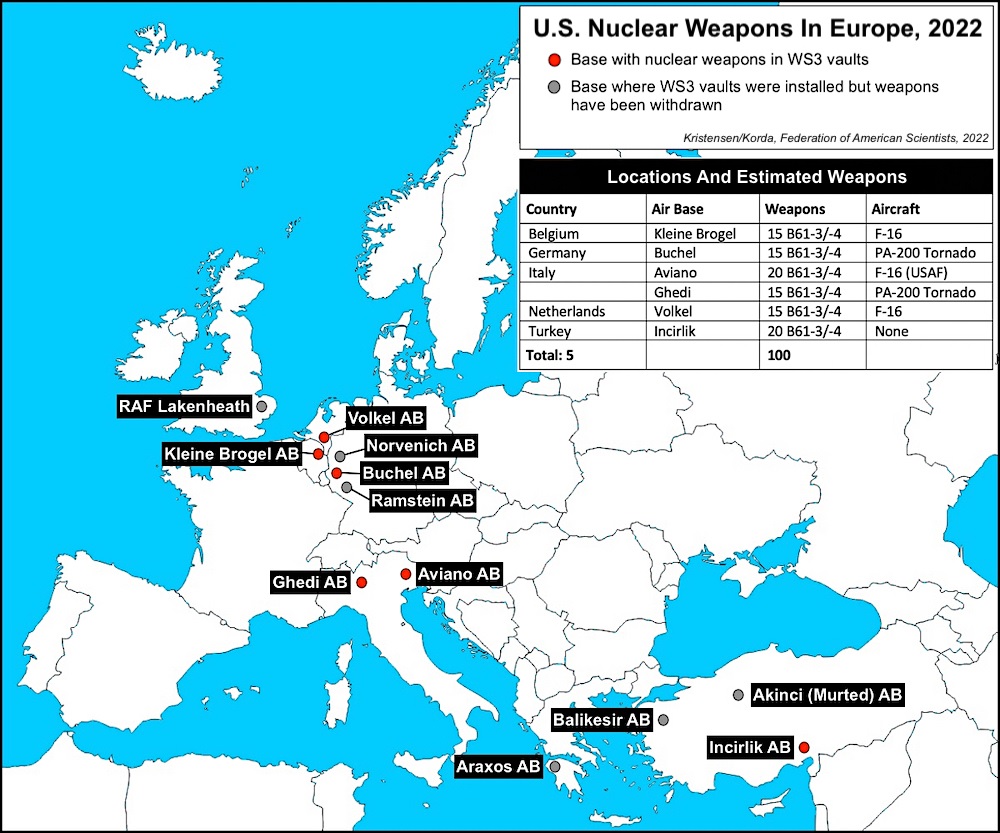
The United States has only one type of nonstrategic nuclear weapon in its stockpile: the B61 gravity bomb. But it exists in several versions: ……………………………………………………. About 100 of these (versions −3 and − 4) are thought to be deployed at six bases in five European countries: Aviano and Ghedi in Italy; Büchel in Germany; Incirlik in Turkey; Kleine Brogel in Belgium; and Volkel in the Netherlands…………………………………………………………………
The Belgian, Dutch, German, and Italian air forces are currently assigned an active nuclear strike role with US nuclear weapons. …………………………………………………………………………………………………………………………..
The United States withdrew nuclear weapons from the United Kingdom around 2007 after storing them at Royal Air Force (RAF) Lakenheath for several decades (Kristensen 2008). But increasing evidence over the past two to three years suggests that the United States may be returning its nuclear mission to UK soil (Korda and Kristensen 2023) (see Figure 3 on original)
……………………………………………………………In addition to the modernization of weapons, aircraft, and bases, NATO also appears to be increasing the profile of the dual-capable aircraft posture. NATO is now publicly announcing its annual Steadfast Noon tactical nuclear weapons exercise. For example, NATO described in 2023 that the exercise involved the participation of 13 countries and 60 aircraft including fighter jets and US B-52 bombers (NATO 2023)………………………………………………………………………………………………
This research was carried out with generous contributions from the New-Land Foundation, the Prospect Hill Foundation, Longview Philanthropy, Ploughshares Fund, and individual donors.
References…………………………………………….. https://thebulletin.org/premium/2024-05/united-states-nuclear-weapons-2024/
South Korean state energy monopoly in talks to build new UK nuclear plant.
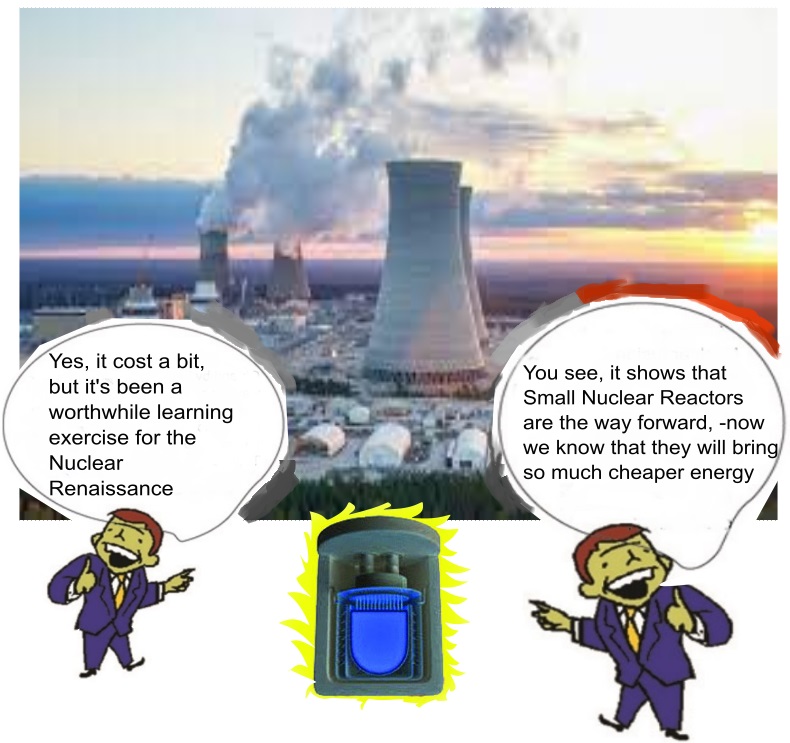
Kepco has held early-stage discussions with British officials over
mothballed Wylfa site. South Korea’s state energy monopoly is in talks
with the UK government about building a new nuclear power station off the
coast of Wales, in what could be a big boost to Britain’s plans for a new
nuclear fleet.
Kepco has held early-stage discussions with British
officials about a new facility at the Wylfa site in Anglesey, and a
ministerial meeting is expected this coming week, according to people
briefed on the matter.
In his March Budget, chancellor Jeremy Hunt
announced the government would buy the mothballed site and another from
Hitachi for £160mn. In 2019, the Japanese industrial group scrapped its
plans to develop a nuclear project at Wylfa, writing off £2.1bn in the
process.
Hunt’s move was designed to facilitate a fresh deal with a new
private sector partner to build a power station at Wylfa, which could boost
the government’s plans to replace Britain’s current ageing fleet of
nuclear power stations.
A consortium including US construction group
Bechtel and US nuclear company Westinghouse has already proposed building a
new plant on the Wylfa site using Westinghouse’s AP1000 reactor
technology.
Another industry figure said Wylfa’s future would depend on a
decision by GB Nuclear, the government quango which now owns the site. GBN
could give the go-ahead for a large reactor or reactors at Wylfa or judge
that it is a suitable site for building a cluster of new “small modular
reactors”.
Supporters of SMRs claim their modular design would make them
relatively quick and cheap to build. “Wylfa is now the next priority site
for the UK so it makes sense that Kepco are interested, but they just need
GBN to make a decision soon about whether they do want a traditional
nuclear power station there,” the figure said.
One senior Korean
government official struck a cautious note about the prospect of Kepco
buying the site, saying that building nuclear power stations in the UK was
“difficult”.
FT 12th May 2024
https://www.ft.com/content/3404a203-158e-4fe1-9f5d-f5fb64032ffc
Fixation on UK nuclear power may not help to solve climate crisis

Waste and cost among drawbacks, as researchers say renewables could power UK entirely
Paul Brown 10 May 24, https://www.theguardian.com/environment/article/2024/may/10/fixation-on-nuclear-power-in-uk-may-not-help-to-solve-climate-crisis
In the battle to prevent the climate overheating, wind and solar are making impressive inroads into the once dominant market share of coal. Even investors in gas plants are increasingly seen as taking a gamble.
With researchers at Oxford and elsewhere agreeing that the UK could easily become entirely powered by wind and solar – with no fossil fuels required – it seems an anomaly that nuclear power is still getting the lion’s share of taxpayer subsidies to keep the ailing industry alive.
Politicians on both sides of the Atlantic are backing as yet unproven small modular reactors (SMRs) as an indispensable part of the answer to the climate crisis and are running competitions to get this industry started. These reactors, from tiny ones of the type that power nuclear submarines, to scaled-up versions that can, in theory, be factory produced and built in relays to provide steady power, are all still in the design stage.
As the Union of Concerned Scientists in the United States points out, whichever model is chosen they have all the drawbacks of existing nuclear power stations; expensive, even without cost overruns, and the still unsolved waste problem. The biggest disadvantage, the group says, is that even if the technology worked it would be too little, too late, to keep the climate safe.
Nano Nuclear wants to reinvent the nuclear power business—but it could take a while.

The company is trying to not only reinvent reactors but also reinvent fuel production and transportation. It’ll take several years yet before we know if it works.
Fast Company, BY TIERNAN RAY 10 May 24
“…….. This week, a two-year-old company, Nano Nuclear Energy, is expected to go public on Nasdaq with a plan to solve what ails the nuclear power business.
The company, officially based on the 30th floor of an office building in New York’s Times Square, is a “distributed” company, meaning, its 27 staff members live and work here and there. The company is run by CEO James Walker, a physicist who was previously a nuclear engineer at Rolls-Royce.
Walker has gathered a mish-mash of engineering talent and former bankers to build what’s called a “microreactor,” also known as a “small modular nuclear reactor,” which can be hitched to a tractor trailer and driven around the country to wherever it is needed—be it a remote mining site that needs power, or an AI data center.
Walker has also assembled a star-studded advisory board that includes former U.S. presidential candidate and NATO commander Wesley Clark, and former New York governor Andrew Cuomo, who hold stock options in the company.
The premise of Nano Nuclear is the same that propels competitors such as privately held Terrapower and X-Energy: conventional nuclear energy is too costly…………………………………………………………………………………………………………………
Nano Nuclear and competitors have jumped on the DOE’s effort to make “advanced” reactors, things so compact they can ride around on a semitruck and be parked where needed. They produce far less energy, on the scale of tens of megawatts, but also can cost far less, claims the DOE, and they can be run with minimal safety oversight because of their advanced design.
Just about every company in nuclear power is working on such innovation, including Westinghouse, Terrapower, X-Energy, and publicly traded NuScale of Portland, Oregon. Walker and team contend, however, that those companies are going about it all wrong. They haven’t done enough to solve the main limiting factor of small reactors, adequate fuel supply, the enriched uranium that creates the nuclear chain reaction.
“Large SMR companies have raised billions of dollars for development but have been stalled by the lag in developing or acquiring the fuel necessary to advance their reactors,” states Nano Nuclear’s IPO prospectus. The fuel is critical because small reactors need uranium with more of the uranium isotope U235 in order to be so compact. It’s the density of power per unit of volume of fuel that lets microreactors be made very small.

The DOE has been fostering collaboration among many parties on what’s called “High-Assay Low-Enriched Uranium,” or, HALEU, which is uranium enriched more than the 5% standard in the industry, as high as 20%. Without enough HALEU, many of the advanced reactors being developed “do not have the fuel supply infrastructure necessary to succeed,” claims Nano Nuclear.
To secure HALEU, Nano Nuclear has started two subsidiaries, one to produce HALEU uranium, HALEU Energy Fuel Inc., and another to transport it in large quantities, Advanced Fuel Transportation, Inc. The company even has a subsidiary to mine for uranium.
You could say Nano Nuclear has formed a vertically integrated nuclear firm, going from uranium mining through fuel production and trucking to supplying the finished reactor.
Will it work? We won’t know for some time. The company’s two proposals for microreactors, “Zeus” and “Odin,” are not even built. The company has no revenue at present. Nano Nuclear hopes to have one of the reactors in production by 2030. The company apparently hasn’t begun the licensing process with the U.S. Nuclear Regulatory Agency, which can take several years. The fuel manufacturing, moreover, is not expected to be operational until 2027……………………….
Nano Nuclear nabbed almost ten million dollars with the IPO, but it expects to need “a significant infusion of additional capital for successful deployment, even following this offering.” Just the Zeus and Odin reactors alone are expected to cost four million dollars to develop. That means potential dilution of investors by lots of follow-on stock offerings.
The tiny staff of 27 is not entirely full-time. All the senior executives, including Walker and CFO Jaisun Garcha, are working as independent contractors, and they all have jobs running other companies.
You can’t scrutinize Nano Nuclear’s technology plans to know if they make sense because Nano Nuclear has filed no patent applications, instead preferring to keep its intellectual property secret.
The rest of this year, Nano Nuclear expects to use its IPO money to buy another company in order to get into the nuclear consulting business. The idea is to get some paying work in order to subsidize Zeus and Odin.
For a long time, then, Nano Nuclear is destined to be a far-less-interesting kind of company that simply has a great idea for the revival of the nuclear industry. https://www.fastcompany.com/91122128/nano-nuclear-reinventing-nuclear-power-business
Biden’s war on Gaza is now a war on truth and the right to protest

media has carefully refocused attention, dealing exclusively with the nature of the protests – and a supposed threat they pose to “order” – not addressing what the protests are actually about.
As ever, establishment journalists have been essential to distracting from these horrendous realities.
The student protest movement has been remarkably peaceful
The media’s role is to draw attention away from what the students are protesting – complicity in genocide – and engineer a moral panic to leave the genocide undisturbed
JONATHAN COOK, MAY 10, 2024, First published by Middle East Eye
As mass student protests quickly spread to campuses across the United States last week, and others took hold in Britain and elsewhere in Europe, the western media gave centre stage to one man to arbitrate on whether the demonstrations should be allowed to continue: US President Joe Biden.
The establishment media reverentially relayed the president’s message that the protests were violent and dangerous, treating his assessment as if it had been handed down on a tablet of stone.
Biden declared the protesters had no “right to cause chaos”, giving the green light for police to go in with even greater force to clear the encampments.
This week, Biden raised the stakes further by suggesting the protests were evidence of a “ferocious surge” of antisemitism in the US.
According to reports, more than 2,000 protesters have been arrested after some university administrators – under growing pressure from the White House and their own wealthy donors – called in local police.
In approving the crushing of dissent, Biden contradicted himself: “We are not an authoritarian nation where we silence people or squash dissent. But order must prevail.”
One small problem went unmentioned: Biden was not a disinterested party. In fact, his conflict of interest was so gigantic it could, like the damage to Gaza, be seen from outer space.
The students were calling on their universities to pull all investments from companies that are assisting Israel in carrying out what the World Court has called a “plausible” genocide in Gaza. Those weapons are being supplied in huge quantities largely thanks to the decisions of one man.
Yes, Joe Biden.
Law-breaking Biden
The “order” the US president wants to prevail is one in which his decisions to block any ceasefire and arm the slaughter, maiming and orphaning of many tens of thousands of Palestinian children go unchallenged.
Biden has been so indulgent of Israel’s destruction of Gaza that Benjamin Netanyahu’s government crossed the president’s supposed “red line” this week. Israel launched the initial stages of its long-threatened final assault on Rafah in southern Gaza. Some 1.3 million Palestinians have been huddling in makeshift tents there.
Biden could easily have forced Israel to change course at any point over the past seven months, but chose not to, even as he feigned concern about the ever-rising death toll among Palestinian civilians. Only under growing popular pressure, fuelled by the protests, has he finally appeared to pause arms shipments as the attack on Rafah intensifies.
The White House has authorised vast shipments of arms to Israel, including 2,000lb bombs that have levelled whole neighbourhoods, killing men, women and children outright or leaving them trapped under rubble to slowly suffocate or starve to death.
Late last month Biden signed a further $26bn of US taxpayers’ money to Israel, the majority military aid – just as mass graves of Palestinians killed by Israel were coming to light. He has been able to do so only by flagrantly ignoring the requirement in US law that any weapons supplied not be used in ways likely to constitute war crimes.
Human rights groups have warned his administration repeatedly that Israel is routinely breaking international law.
At least 20 of Biden administration’s own lawyers are reported to have signed off on a letter that Israel’s actions violate a host of US statutes, including the Arms Export Control Act and Leahy Laws, as well as the Geneva Conventions.
Meanwhile, the State Department’s investigations show that, even before Israel’s destruction of Gaza began seven months ago, five Israeli military units were committing gross violations of the human rights of Palestinians in the separate enclave of the Occupied West Bank.
There, Israel doesn’t even have the one-size-fits-all excuse that the abuse and killing of Palestinian civilians are unfortunate “collateral damage” in an operation to “eradicate Hamas”. The West Bank is under the control of the Palestinian Authority of Mahmoud Abbas, not Hamas.
Nonetheless, no action has been taken to stop the arms transfers. US laws, it seems, don’t apply to the Biden administration, any more than international law does to Israel.
Protest quicksand
In denying students the right to protest at the US arming of Israel’s plausible genocide, Biden is also denying them the right to protest the most consequential policy of his four-year term – and of at least the last two decades of US foreign policy, since the US invasion of Iraq.
And it is all happening in a presidential election year.
The students’ immediate aim is to stop their universities’ complicity in the slaughter of tens of thousands of Palestinians in Gaza. But there are two obvious wider goals.
The first is to bring attention back to the endless suffering of Palestinians in the tiny, besieged enclave. Until this week’s attack on Rafah, the plight of Gaza had increasingly dropped off front pages, even as Israeli-induced famine and disease tightened their grip over the past month.
When Gaza has made the news, it is invariably through a lens unrelated to the slaughter and starvation. It is details of the interminable negotiations, or political tensions over Israel’s Rafah “invasion”, or plans for the “day after” in Gaza, or the plight of the Israeli hostages, or their families’ agonies, or where to draw the line on free speech in criticising Israel.
The students’ second goal is to make it politically uncomfortable for Biden to continue providing the weapons and diplomatic cover that have permitted Israel’s actions – from slaughter to starvation, and now the imminent destruction of Rafah.
The students have been trying to change the national conversation in ways that will pressure Biden to stop his all-too-visible law-breaking.
But they have run up against the usual problem: the national conversation is largely dictated by the political and media class in their own interests. And they are all for the genocide continuing, it seems, whatever the law says.
Which means the media has carefully refocused attention, dealing exclusively with the nature of the protests – and a supposed threat they pose to “order” – not addressing what the protests are actually about.
Last Sunday, the head of the UN Food Aid Programme, Cindy McCain, warned that northern Gaza was in the grip of “full-blown famine” and that the south was not far behind. Dozens of children were reported to have died of dehydration and malnutrition. “It’s horror,” she said.
The head of Unicef pointed out last week, a few days before Israel ordered the evacuation of eastern Rafah: “Nearly all of the some 600,000 children now crammed into Rafah are either injured, sick, malnourished, traumatized, or living with disabilities.”
A separate UN report recently revealed it will take 80 years to rebuild Gaza, based on the historic levels of materials allowed in by Israel. On a highly unlikey, best-case scenario, it will take 16 years.
As ever, establishment journalists have been essential to distracting from these horrendous realities.
The students are caught in a protest equivalent of quicksand: the more they struggle to draw attention to the Gaza genocide, the more the Gaza genocide sinks from view. The media have seized on their struggle as a pretext to ignore Gaza and turn the spotlight on to their protests instead.
Feeling ‘unsafe’
The student protest movement has been remarkably peaceful – a fact that is all the more obvious when compared to the Black Lives Matter protests that swept the US in 2020, with Biden’s approval.
Four years ago there were many episodes of property damage, but that has been all but unheard of in the student protests, which are mostly confined to encampments on university campus lawns………………………………………………………………………………………………………………………………… more https://jonathancook.substack.com/p/bidens-war-on-gaza-is-now-a-war-on?utm_source=post-email-title&publication_id=476450&post_id=144499809&utm_campaign=email-post-title&isFreemail=true&r=ln98x&triedRedirect=true&utm_medium=email
France wants to extend its nuclear umbrella to Europe. But is Macron ready to trade Paris for Helsinki?

Bulletin By Carine Guerout, Jason Moyer | May 10, 2024
Europe’s reliance on US nuclear weapons has been at the heart of the transatlantic security relationship, and so has been the protection that the old continent gets from being part of the NATO alliance and its powerful Article 5. Now, the debate about nuclear deterrence for the European Union is back at the forefront, in part due to the prospects of a reticent United States under a possible second Trump presidency and a resurgent Russia increasingly threatening to use nuclear weapons.
NATO, as a nuclear alliance, relies heavily on US nuclear warheads stationed in Europe for its deterrence. The United Kingdom and France are Europe’s only nuclear powers: Although part of NATO, they maintain independent control over their own nuclear arsenals. In the past, the European Union has been reluctant—or incapable—of providing nuclear deterrence. But the uncertain security environment in Europe has recently led the Union to strengthen its previously neglected security pillar—and, with it, caused some political leaders to become more vocal about nuclear weapons.
In recent weeks, France’s President Emmanuel Macron, in his classic disrupting style, has openly called for debate in Europe over using his country’s nuclear capabilities to defend the continent. In Macron’s view the uncertainty over future US engagement in Europe is forcing the European Union to decide whether it needs a nuclear deterrent of its own—and suggests France may help with this. But it is not clear whether France would be willing—and capable—of extending its nuclear umbrella to the rest of the Union. For this to happen, France would need to address multiple issues, starting with explaining whether it would retain full decision-making over its arsenal, exploring the limitations of its current stockpile of nuclear weapons, and weighing the impact such a decision would have on NATO and its relations with the United States and its fellow EU member states.
Macron’s insistence. Since the United Kingdom’s withdrawal from the European Union in 2020‚—popularly known as “Brexit”—France has become the Union’s only country with nuclear weapons. France possesses approximately 290 nuclear weapons (the world’s fourth arsenal in terms of stockpiles warheads behind Russia, the United States, and China). Ever since French President Charles de Gaulle’s famous questioning of US nuclear assurances in 1961— which led France to develop its own nuclear deterrence force—France has historically seen itself as an independent force counterbalancing that of the United States in Europe. This spirit persists today: France still does not participate in NATO’s Nuclear Planning Group and remains one of the Western allies most in favor of nuclear deterrence. France’s independent deterrence strengthens NATO overall because it complicates the calculus of adversaries. Although nuclear deterrence has been a cornerstone of NATO’s deterrence posture, the same cannot be said of the European Union: Many member states remain uncertain about the role of nuclear weapons in defense planning.
The debate over the nuclear readiness of the EU is not new. Traditionally, the holdout to developing a so-called “Eurobomb” has been Germany. In recent years, a growing number of German policy makers have asked the previously unthinkable question of whether it should possess its own nuclear weapons. The German public remains unconvinced, however: Even after the Russian invasion of Ukraine, 90 percent of Germans still reject the idea of their country developing a nuclear weapons program and it seems unlikely the German public will dramatically pivot toward a Eurobomb. Traditionally neutral EU countries such as Ireland, Malta, and Austria are not likely to be willing to support the bomb either: All three are signatories to the Treaty on the Prohibition of Nuclear Weapons (TPNW), also known as the ban treaty, and would likely block any attempt to extend France’s nuclear arsenal to Europe…………………………………………………………………………………………..
Easier said than done. To move forward with his proposal, President Macron will need to answer at least three critical questions about the politics and logistics of a European-level nuclear weapon sharing arrangement. First, France will need to clarify whether it wants to retain full decision-making power over its nuclear arsenal. ……………………………………..
Second, it is not clear how France could realistically provide nuclear deterrence to the entire Union. French nuclear forces have limited capabilities, with a much smaller and less diversified arsenal than that of other major nuclear powers, and its nuclear deterrence has been developed for a strictly defensive purpose. France partially disarmed its nuclear arsenal in the 1990s after the Cold War, reducing its nuclear stockpiles from 600 warheads to just under 300……………………………………………………………
In practice, the idea of a French nuclear umbrella for Europe also raises a third question for Macron: How to embed the French nuclear armament into existing European structures and how this shift would complement NATO’s capabilities in Europe……………………………………………………………………. https://thebulletin.org/2024/05/france-wants-to-extend-its-nuclear-umbrella-to-europe-but-is-macron-ready-to-trade-paris-for-helsinki/
US Defenseless Against Russian Hypersonic Missiles and Iranian Drones – Explosive DoD Testimony
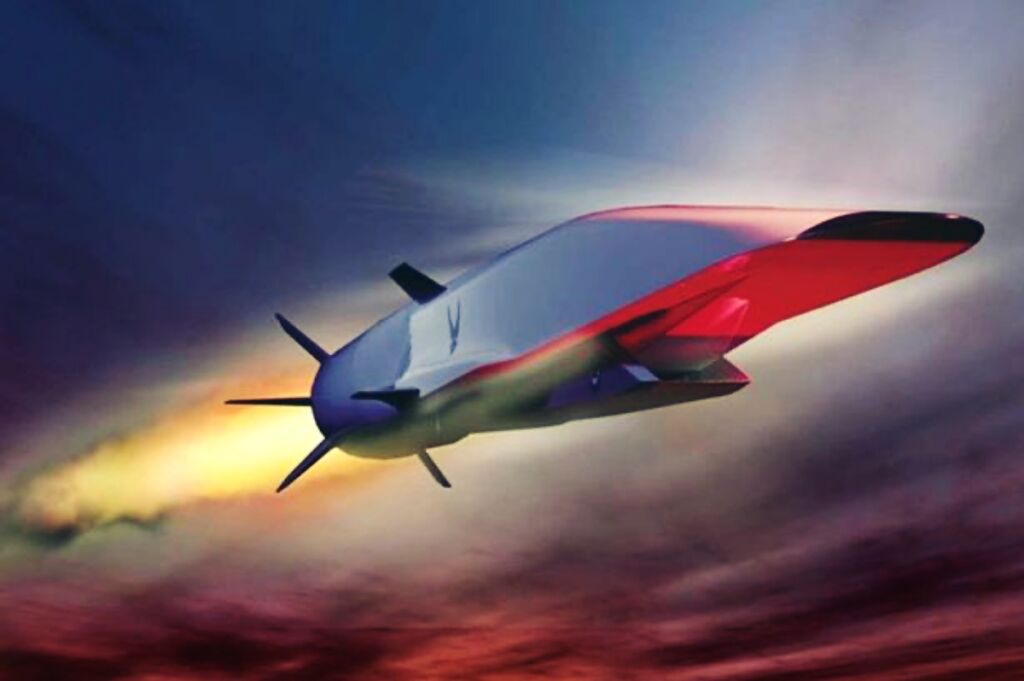
The crisis in Ukraine and escalating tensions in the Middle East have demonstrated that the US’ $886 billion defense budget has not translated into real-world capabilities on the ground. Now, an explosive verbal exchange on Capitol Hill has revealed that North America’s skies are defenseless against not only Russian, but even Iranian missiles.
An otherwise boring and formulaic briefing by senior Pentagon officials to lawmakers from the Senate Armed Services Subcommittee on Strategic Forces went off the rails on Wednesday after subcommittee Chairman Angus King took the floor and forced Department of Defense officials to reveal that North America is helpless against adversaries it has spent years agitating around the world.
“The truth is we have no defense for hypersonic missiles – yes or no? Mr. Hill, any defense on the hypersonic missile? You’re the commander of an aircraft carrier in the Greenland Gap. If we have a hypersonic missile launched from Murmansk [traveling at] 6,000 miles an hour, what do you do?” King asked, querying Deputy Secretary of Defense for Space and Missile Defense John Hill.
“We have some systems to defend in the terminal stage but we need more, you’re correct, Senator King… that our hypersonic defenses are inadequate and we do need [more]. SM-6 is in the Navy’s terminal range [capability], the Patriot – I’ll let General Gainey speak to the specifics on that. Those are examples but no argument, we need to focus on hypersonic defenses,” Hill responded.
“So why are we talking about 2029 and even stretching that out? This is next year kind of stuff. I don’t get your budget,” King countered, referencing the lack of focus on anti-hypersonic capabilities in current US defense spending plans.
“What we faced in the budget this year – it was a difficult year, particularly with the Fiscal Responsibility Act caps that we had to work with. There were must-pay bills that we had to work with for the personnel, the salaries, the health care, inflation costs. When you get down to the point of where you get down to the discretionary types of things where you can really control your choices,” Hill said.
“But that’s your mission – your mission is missile defense,” King retorted.
“The budget decisions are made at a higher level and so you’re trading off between readiness or your future investments,” Hill said.
“Well let me put the question another way: let’s say what happened on April 14 [Iran’s retaliatory missile and drone attack on Israel, ed.] happened over the Arctic Ocean – 300 missiles, drones, UAVs came across the Arctic Ocean toward Canada and North America. Could we do what Israel and we and other countries did – could we knock down 99 percent of those missiles coming in?” King asked.
“No chairman,” Air Force General Gregory Guillot, commander of US Northern Command and North American Aerospace Defense Command (NORAD), responded.
“That’s of concern,” King said. “What’s the gap – is the gap interceptors, is the gap sensors? How come they could do it over there and we can’t do it here?” he asked.
“Part of the reason, Mr. Chairman, is because they have the deployed forces. So at the current time we have the capability in the services but they’re not assigned to Northcom’s area of responsibility,” Guillot said. “Also, just the numbers of the assets that we have in the region right now would not be sufficient to meet the attack of that size that the Iranians [used].”
“And in fact our capability in the region is really aimed toward North Korea, isn’t that correct? […] It’s not designed to take on Russia or China. But that’s where the threat is. What’s the cost of one GBI?” King asked, referring to the US’ Ground-Based Interceptor anti-ballistic missile system.
“Sir, the GBI is approximately $80-$85 million,” Hill replied.
“One missile to intercept an incoming missile is $80 million,” an astonished King said. “Well in the Red Sea, the Houthis are sending $20,000 drones and we’re shooting them down with missiles that cost $4.3 million. The math doesn’t work on that, gentlemen. It just doesn’t work. What are we thinking?”
The senator went on to grill Pentagon officials for spending just one 1,000th of the defense budget on directed energy defenses, asking “what in the hell are you guys thinking?”
“Directed energy is the answer. It costs 25 cents a shot, and the budget’s gone down from $140 to $15 million a year. That’s a scandal. We can’t possibly defend ourselves with $80 million missiles. There’s not enough money in the whole world for that,” King emphasized.
“So I’ll look forward to some further response because right now, we don’t have much missile defense. Whether it’s to hypersonics, to drones, I’d like you guys to go back and really rethink what is your mission. If your mission is missile defense, we need to reorient what it is you do,” the senator summed up.
Iran warns it will change nuclear doctrine if ‘existence threatened’

Adviser to Khamenei says Iran will have ‘no choice’ if nuclear facilities targeted by Israel.
Iran could be pushed into building a nuclear weapon if Israel threatens its existence, an adviser to the country’s supreme leader has warned.
“We have no decision to build a nuclear bomb but should Iran’s existence be threatened, there will be no choice but to change our military doctrine,” said Kamal Kharrazi, an adviser to Supreme Leader Ayatollah Ali Khamenei, on Thursday.
“In the case of an attack on our nuclear facilities by the Zionist regime, our deterrence will change,” he was reported as saying by Iran’s Student News Network.
The comments have raised questions about what Iran has long claimed is a peaceful nuclear programme.
Khamenei, who has the final say on the matter, banned the development of nuclear weapons in a fatwa, or religious edict, in the early 2000s, saying it is “haram”, or forbidden in Islam.
But in 2021, Iran’s then-intelligence minister said Western pressure could push the Islamic republic to seek nuclear weapons.
Iran is enriching uranium to up to 60 percent purity, whereas weapons-grade uranium is enriched to about 90 percent. If the current nuclear material on hand were enriched further, it would suffice for two nuclear weapons, according to an official yardstick by the International Atomic Energy Agency (IAEA).
Escalating threat
The shadow war between Iran and Israel erupted into open confrontation in April, after a suspected Israeli strike on Iran’s embassy compound in the Syrian capital, Damascus, which killed seven members of Iran’s Islamic Revolutionary Guard Corps (IRGC), including two generals who led the elite Quds Force in Syria and Lebanon.
Iran retaliated by launching about 300 missiles and drones against Israel.
Israel has regularly launched attacks on targets linked to Iran and the Lebanese group Hezbollah in Syria since 2017, increasing the frequency and intensity of strikes on the so-called “axis of resistance” since the start of its war on Gaza last October.
On Thursday, Syrian air defences shot down what the defence ministry said were Israeli missiles fired from the Golan Heights in northern Israel towards the outskirts of Damascus, targeting a building in the countryside, according to Syrian state news agency SANA.
The attack, at about 3:20am (00:20 GMT), caused “some material losses”, the report said.
US Congress passes major, bipartisan nuclear energy legislation

The House approved a bill Wednesday that includes major, bipartisan nuclear
energy legislation, keeping alive what may be the best hope for passing a
compromise nuclear bill before the end of the year. The chamber voted
393-13 to send S. 870, the “Fire Grants and Safety Act,” to the Senate
after lawmakers attached the “Accelerating Deployment of Versatile,
Advanced Nuclear for Clean Energy (ADVANCE) Act of 2024.” The fire grants
bill, sponsored by Sen. Gary Peters (D-Mich.), easily passed the Senate
last year, offering what lawmakers and nuclear energy backers believe could
be a nearly bulletproof vehicle for the bipartisan “ADVANCE Act.”
EE News 9th May 2024
United Nations General Assembly backs Palestinian bid for membership
Aljazeera, 10 May 24
Resolution does not give Palestine full UN membership, but recognises them as qualified to join and extends rights.
The United Nations General Assembly (UNGA) has backed a Palestinian bid to become a full UN member by recognising it as qualified to join and recommending the UN Security Council “reconsider the matter favourably”.
The vote by the 193-member UNGA on Friday was a global survey of support for the Palestinian bid to become a full UN member – a move that would effectively recognise a Palestinian state – after the United States vetoed it in the UN Security Council last month.
The assembly adopted a resolution on Friday with 143 votes in favour and nine against – including the US and Israel – while 25 countries abstained. It does not give the Palestinians full UN membership, but simply recognises them as qualified to join.
The UNGA resolution “determines that the State of Palestine … should therefore be admitted to membership” and it “recommends that the Security Council reconsider the matter favourably”.
While the UNGA alone cannot grant full UN membership, the draft resolution on Friday will give the Palestinians some additional rights and privileges from September 2024 – like a seat among the UN members in the assembly hall – but it will not be granted a vote in the body.
Reporting from the UN headquarters in New York, Al Jazeera’s Gabriel Elizondo said it was significant that such a high number of countries voted in favour of the resolution.
“What we were hearing before the vote was anywhere perhaps between 120, 130 – at top end, 140. The fact that they got 143 meets and exceeds all expectations. It’s been overwhelmingly passed,” he said.
“But they still only have observer status.”…………………………… more https://www.aljazeera.com/news/2024/5/10/un-general-assembly-backs-palestinian-bid-for-membership
NuScale, maker of small nuclear reactors, reported revenue of $1.4 million and net loss of $48.1 million for the three-month period ended March 31, 2024

NuScale reported revenue of $1.4 million and net loss of $48.1 million for
the three-month period ended March 31, 2024, compared to revenue of $5.5
million and a net loss of $35.6 million for the same period in 2023. Higher
net loss reported in the period was driven by a one-time $3.2 million
charge associated with continuing our transition from an R&D-based company
to commercial operations, and a $9.0 million non-cash adjustment to the
fair value of our warrants due to an increase in the Company’s share price.
Business Wire 9th May 2024
Venezuela may be first nation to lose all its glaciers

10 May 24, Aleks Phillips, BBC News
Venezuela may be the first nation in modern history to lose all its glaciers after climate scientists downgraded its last one to an ice field.
The International Cryosphere Climate Initiative (ICCI), a scientific advocacy organisation, said on X that the South American nation’s only remaining glacier – the Humboldt, or La Corona, in the Andes – had become “too small to be classed as a glacier”.
Venezuela has lost at least six other glaciers in the last century.
With global average temperatures rising due to climate change, ice loss is increasing, helping to raise sea levels around the world…………………………………………………………………………………………………………………………… https://www.bbc.com/news/articles/cx8qv1nvdppo
NuScale Power Corporation (SMR) Reports Q1 Loss, Misses Revenue Estimates
Zacks Equity Research, Fri, 10 May 2024
NuScale Power Corporation (SMR) came out with a quarterly loss of $0.21 per share in line with the Zacks Consensus Estimate. This compares to loss of $0.16 per share a year ago. These figures are adjusted for non-recurring items.
A quarter ago, it was expected that this company would post a loss of $0.22 per share when it actually produced a loss of $0.25, delivering a surprise of -13.64%.
Over the last four quarters, the company has not been able to surpass consensus EPS estimates.
NuScale Power , which belongs to the Zacks Electronics – Power Generation industry, posted revenues of $1.38 million for the quarter ended March 2024, missing the Zacks Consensus Estimate by 56.22%. This compares to year-ago revenues of $5.51 million. The company has topped consensus revenue estimates just once over the last four quarters.
The sustainability of the stock’s immediate price movement based on the recently-released numbers and future earnings expectations will mostly depend on management’s commentary on the earnings cal
……………………………………………………. the shares are expected to underperform the market in the near future. ………………………….. https://au.finance.yahoo.com/news/nuscale-power-corporation-smr-reports-213506291.html
-
Archives
- December 2025 (223)
- November 2025 (359)
- October 2025 (377)
- September 2025 (258)
- August 2025 (319)
- July 2025 (230)
- June 2025 (348)
- May 2025 (261)
- April 2025 (305)
- March 2025 (319)
- February 2025 (234)
- January 2025 (250)
-
Categories
- 1
- 1 NUCLEAR ISSUES
- business and costs
- climate change
- culture and arts
- ENERGY
- environment
- health
- history
- indigenous issues
- Legal
- marketing of nuclear
- media
- opposition to nuclear
- PERSONAL STORIES
- politics
- politics international
- Religion and ethics
- safety
- secrets,lies and civil liberties
- spinbuster
- technology
- Uranium
- wastes
- weapons and war
- Women
- 2 WORLD
- ACTION
- AFRICA
- Atrocities
- AUSTRALIA
- Christina's notes
- Christina's themes
- culture and arts
- Events
- Fuk 2022
- Fuk 2023
- Fukushima 2017
- Fukushima 2018
- fukushima 2019
- Fukushima 2020
- Fukushima 2021
- general
- global warming
- Humour (God we need it)
- Nuclear
- RARE EARTHS
- Reference
- resources – print
- Resources -audiovicual
- Weekly Newsletter
- World
- World Nuclear
- YouTube
-
RSS
Entries RSS
Comments RSS


